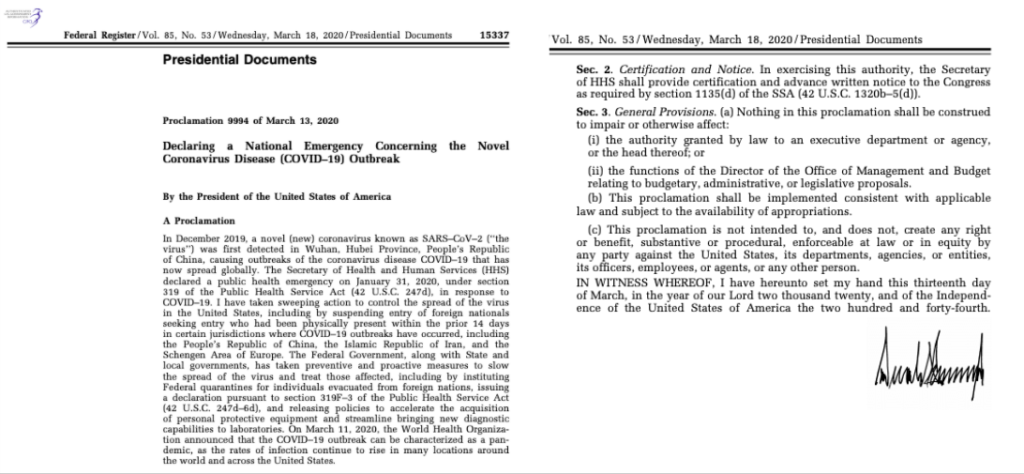US National Emergencies Mapped
The novel coronavirus has plagued the world and the United States throughout 2020 and beyond. With a death count surpassing even the highest of early estimates, COVID-19 is incomparable to previous diseases. Even the most recent pandemic, 2009’s H1N1 (also known as “Swine Flu”), resulted in much fewer deaths.
But these diseases do have something in common: they each resulted in the declaration of a national emergency by the President of the United States. When this is proclaimed, the government can perform actions not normally allowed. Throughout American history, presidents have declared 69 of these emergency orders. Of these, 34 have since expired while another 35 are currently in effect, each having been renewed annually by the president.
To gain a better understanding of these emergencies, we’ll cover their eight categories, those that are current, and the presidents who declared the most. You can also view this information, and the location of each, on the map below.
View National emergencies in the United States in a full screen map
Each marker on the map comes from Wikipedia’s List of national emergencies in the U.S.. Each of these emergencies has been categorized, which you can read more about below.
National Emergency Categories
Most (46) of the U.S.’s national emergencies can be classified as sanctions (punishments one country puts on another country hoping for a change in behavior). Other common reasons for emergencies include:
- Trade (8)
- Military (5)
- Arms (3)
- Public health (2)
- Maritime (2)
- Economic (2)
- Legal (1)
Only one of the eight trade emergencies has remained intact: the Continuation of Export Control Regulations. As for military emergency orders, two of the five are ongoing: one from the 9/11 terrorist attacks and the 2019 Declaring a National Emergency Concerning the Southern Border of the United States. You can group the map by the rest of the national emergencies to learn more. Otherwise, let’s take a closer look at how many emergency orders remain to this day.
The 35 Current National Emergencies

“Current” national emergencies include those that were created in the same year or emergency orders from previous years the current president renewed. As of early November 2020, 34 national emergencies have ended while 35 are current. Below you’ll find the current emergency declarations, starting with the most recent.
Interactive Maps Made Easy
Sign Up Now| Emergency name | Date | Year | Category | President | Country |
|---|---|---|---|---|---|
| Declaring a National Emergency Concerning the Novel Coronavirus Disease COVID-19 Outbreak | March 13 | 2020 | Public health | Trump | US |
| Blocking Property of Certain Persons Associated with the International Criminal Court | June 11 | 2020 | Sanctions | Trump | Afghanistan |
| Securing the Information and Communications Technology and Services Supply Chain | May 15 | 2019 | Sanctions | Trump | China |
| Declaring a National Emergency Concerning the Southern Border of the United States | February 15 | 2019 | Military | Trump | Mexico |
| Imposing Certain Sanctions in the Event of Foreign Interference in a United States Election | September 12 | 2018 | Sanctions | Trump | Russia |
| Blocking Property of Certain Persons Contributing to the Situation in Nicaragua | November 27 | 2018 | Sanctions | Trump | Nicaragua |
| Blocking the Property of Persons Involved in Serious Human Rights Abuse or Corruption | December 20 | 2017 | Sanctions | Trump | Myanmar |
| Blocking Property of Certain Persons Contributing to the Situation in Burundi | November 22 | 2015 | Sanctions | Obama | Burundi |
| Blocking Property and Suspending Entry of Certain Persons Contributing to the Situation in Venezuela | March 8 | 2015 | Sanctions | Obama | Venezuela |
| Blocking the Property of Certain Persons Engaging in Significant Malicious Cyber-Enabled Activities | April 1 | 2015 | Sanctions | Obama | North Korea |
| Blocking Property of Certain Persons Contributing to the Conflict in the Central African Republic | May 12 | 2014 | Sanctions | Obama | Central African Republic |
| Blocking Property of Certain Persons Contributing to the Situation in Ukraine | March 6 | 2014 | Sanctions | Obama | Ukraine |
| Blocking Property of Certain Persons With Respect to South Sudan | April 3 | 2014 | Sanctions | Obama | South Sudan |
| Blocking Property of Persons Threatening the Peace, Security, or Stability of Yemen | May 16 | 2012 | Sanctions | Obama | Yemen |
| Blocking Property of Transnational Criminal Organizations | July 24 | 2011 | Sanctions | Obama | Mexico |
| Blocking Property and Prohibiting Certain Transactions Related to Libya | February 25 | 2011 | Sanctions | Obama | Libya |
| Blocking Property of Certain Persons Contributing to the Conflict in Somalia | April 12 | 2010 | Sanctions | Obama | Somalia |
| Continuing Certain Restrictions With Respect to North Korea and North Korean Nationals | June 26 | 2008 | Sanctions | Bush | North Korea |
| Blocking Property of Persons Undermining the Sovereignty of Lebanon or Its Democratic Processes and Institutions | August 1 | 2007 | Sanctions | Bush | Lebanon |
| Blocking Property of Certain Persons Contributing to the Conflict in the Democratic Republic of the Congo | October 27 | 2006 | Sanctions | Bush | Democratic Republic of the Congo |
| Blocking Property of Certain Persons Undermining Democratic Processes or Institutions in Belarus | June 16 | 2006 | Sanctions | Bush | Belarus |
| Blocking Property of Certain Persons and Prohibiting the Export of Certain Goods to Syria | May 11 | 2004 | Sanctions | Bush | Syria |
| Protecting the Development Fund for Iraq and Certain Other Property in Which Iraq Has an Interest | May 22 | 2003 | Legal | Bush | Iraq |
| Blocking Property of Persons Undermining Democratic Processes or Institutions in Zimbabwe | March 6 | 2003 | Sanctions | Bush | Zimbabwe |
| Blocking Property and Prohibiting Transactions With Persons Who Commit, Threaten To Commit, or Support Terrorism | September 23 | 2001 | Sanctions | Bush | Afghanistan |
| Declaration of National Emergency by Reason of Certain Terrorist Attacks | September 14 | 2001 | Military | Bush | Afghanistan |
| Blocking Property of Persons Who Threaten International Stabilization Efforts in the Western Balkans | June 26 | 2001 | Sanctions | Bush | North Macedonia |
| Continuation of Export Control Regulations | August 17 | 2001 | Trade | Bush | US |
| Blocking Sudanese Government Property and Prohibiting Transactions With Sudan | November 3 | 1997 | Sanctions | Clinton | Sudan |
| Declaration of a National Emergency and Invocation of Emergency Authority Relating to the Regulation of the Anchorage and Movement of Vessels | March 1 | 1996 | Maritime | Clinton | Cuba |
| Blocking Assets and Prohibiting Transactions with Significant Narcotics Traffickers | October 21 | 1995 | Sanctions | Clinton | Colombia |
| Prohibiting Certain Transactions with Respect to the Development of Iranian Petroleum Resources | March 15 | 1995 | Sanctions | Clinton | Iran |
| Prohibiting Transactions With Terrorists Who Threaten To Disrupt the Middle East Peace Process | January 23 | 1995 | Sanctions | Clinton | Palestine |
| Proliferation of Weapons of Mass Destruction | November 14 | 1994 | Arms | Clinton | US |
| Blocking Iranian Government Property | November 14 | 1979 | Sanctions | Carter | Iran |
Of the 35 current national emergencies, seven were enacted by the recent Trump administration. That leaves 28 emergency orders in effect from past administrations the current president has continuously renewed. The oldest of these is the: Blocking Iranian Government Property (Executive Order 12170) from Jimmy Carter, who ordered the freezing of Iranian assets as part of the U.S. response during the Iran hostage crisis on November 14th, 1979.
Interactive Maps Made Easy
Sign Up NowThe most recent national emergency is, of course, Declaring a National Emergency Concerning the Novel Coronavirus Disease COVID-19 Outbreak (Proclamation 9994) proclaimed by Donald Trump on March 13, 2020. Let’s see how the numbers of national emergencies of the recent president compare to his predecessors.
Presidents Who Declared the Most Emergency Orders
While ‘most national emergencies’ isn’t a typical goal of a new POTUS, there’s no denying some U.S. presidents declared more than others. And only one has proclaimed 15+ national emergencies throughout his terms. So which president was the host with the most? That honor goes to #42—Bill Clinton.
- Clinton – 17 national emergencies
- Bush – 13
- Obama – 12
- Trump – 7
- Reagan – 6
- Bush (H.W.) – 5
Of the 17 national emergencies Bill Clinton declared, 11 are no longer in effect. That leaves six that remain to this day. These can further be broken down into four of the national emergency categories: sanctions (11), trade (3), arms (2), and maritime (1) emergencies.
Aside from Clinton, both George W. Bush and Barack Obama declared more than ten national emergencies throughout their time in office. Two of Bush’s 13 proclamations followed the September 11 attacks. The first was the Declaration of National Emergency by Reason of Certain Terrorist Attacks on September 14 which was followed on September 23 by the Blocking Property and Prohibiting Transactions With Persons Who Commit, Threaten To Commit, or Support Terrorism. Both of these are still in effect, along with nine others.
Find More Meaning in Location Data
Each of the U.S.’s 69 Executive Orders or Proclamations were passed by the U.S. President to protect the country. Many were a result of issues inside the U.S. like Declaring a National Emergency Concerning the Novel Coronavirus Disease COVID-19 Outbreak (Proclamation 9994). However, some were in response to international incidents, i.e. Blocking Property of Persons Threatening the Peace, Security, or Stability of Yemen (Executive Order 13611).
As you saw on the map, Afghanistan and Russia were the subjects of the most emergency orders at four each while Iran was a hot topic of three. This is the sort of insight we may have missed had we just kept the data stored in Google Sheets or Excel.

When your spreadsheet contains geographic data like addresses, coordinates, or even just countries and the occasional city, how can you be expected to analyze the information? In these instances, free mapping tools like BatchGeo can help you find more meaning in your data with customizable maps.
